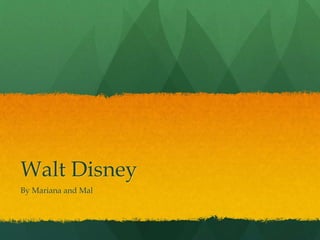
Presentation1 mal
- 1. Walt Disney By Mariana and Mal
- 2. Who is Walt Disney? Walter Elias “Walt” Disney (December 5, 1901 – December 15, 1966) was an American cartoonist, filmmaker, voice actor and many more. He is a ‘cultural icon’. He influenced many and contributed to entertainment during the 20th century. He began at McKinley High School and took night courses at the Chicago Academy of Fine Arts. He became a cartoonist for the school newspaper, drawing patriotic topics on World War 1. He dropped out of school when he was 16 to accomplish his plans of joining the army. Yet that was not the case, he was rejected as he was underage. He spent a year in France, he drove ambulances. In 1919 he moved back to Kansas City to begin his artist career. Walt Disney was influenced by artist and educator, Louis Grell, as he was taught by him at The Chicago Academy of Fine Art. He also met a cartoonist named Ubbe lwerks, who also inspired him.
- 3. Walt Disney’s Catalogue of Work All of Walt Disney’s animations have similar styles. The drawings and sketches are similar to each other. For example, the facial expressions have a lot of detail and the body structure of all the characters is realistic. The characters were different from other animators which appealed to audiences.
- 4. Techniques There were lots of process’ that Disney had to go through to create animations. Disney had very creative thinking techniques. He was a dropout and faced many business disasters and bankruptcy. He overcame his personal financial challenges by using his imagination to create an entertainment empire that has touched and influenced so many people. He used the word “Imagineering”. This term was a combination between imagination and engineering. Disney's thinking technique synthesized three strategies: The dreamer: Spins fantasies, wishes, outrageous hunches, bold and absurd ideas without limits or judgment. Realist: Imagineers the dreamer’s ideas into something realistic and feasible. Working out ideas into meaningful orders. The critic: reviews all the ideas and punch holes in them by playing the devil’s advocate. If things make sense and how it looks to a customer.
- 5. The Purpose The purpose of Walt Disney’s animation was too entertain audiences. The main audience was young people. Most animations are used for positive purposes. All of Walt Disney’s stories had morals and that is why these animations would be aimed at younger audiences. Reasons why these animation ideas were made was to appeal to audiences and play with peoples emotions. Make them happy or make them sad and most of all, entertain them. It would teach people morals of stories and teach children what is stereotypically right and wrong.
- 6. Reviews The top ranked Disney Movies ever: 1. The Lion King- Rotten Tomatoes – “Emotionally stirring, richly drawn, and beautifully animated, The Lion King stands tall within Disney's pantheon of classic family films.” 2. Beauty and the Beast – Roger Ebert - “Beauty and the Beast reaches back to an older and healthier Hollywood tradition in which the best writers, musicians and filmmakers are gathered for a project on the assumption that a family audience deserves great entertainment.” 3. Aladdin – Rotten Tomatoes – “A highly entertaining entry in Disney's renaissance era, Aladdin is beautifully drawn, with near-classic songs and a cast of scene-stealing characters.” 4. Finding Nemo – Metacritic.com – “Dazzles us with computer-generated animation that has never looked quite so boldly exotic or shimmeringly beautiful.” 5. Little Mermaid – Rotten Tomatoes – “The Little Mermaid ushered in a new golden era for Disney animation with warm and charming hand-drawn characters and catchy musical sequences.”
- 7. How Disney’s Work Influenced Other Animation Walt Disney’s many animations that influenced other animators. Matt Groening, maker of The Simpsons, became interested in cartoons after watching the Disney animated film “One Hundred and One Dalmatians.” In the public eye, Disney was simple and happy and he had a signature style. This made other animators want to have a signature style just like Disney. Many cartoons look similar to Walt Disney’s work in this period of animation, it is very clear that he is a massive influence on todays animators.
- 8. The 12 Principles of Animation and Affordances The 12 Principles of Animation were introduced by Disney animators, Ollie Johnston and Frank Thomas in 1981. They used the basic laws of physics and created them. Principles like Squash and Stretch, Anticipation, Staging Solid Drawing, and exaggeration played a massive part to the animation world. It gave the animations depth and originality. Affordances of technology can be defined as “the ways in which technology offers or supports certain things” The characters which sing and dance and are not real have become real because of animation.